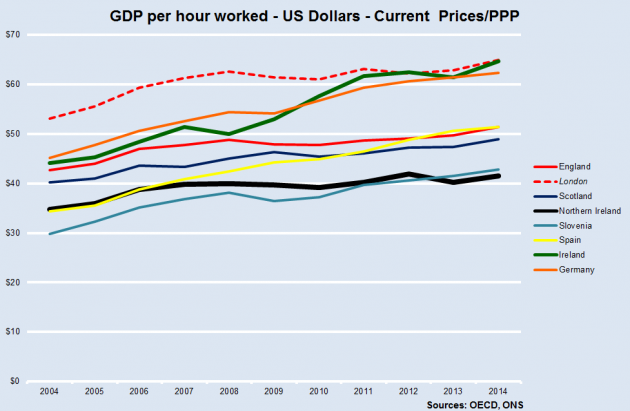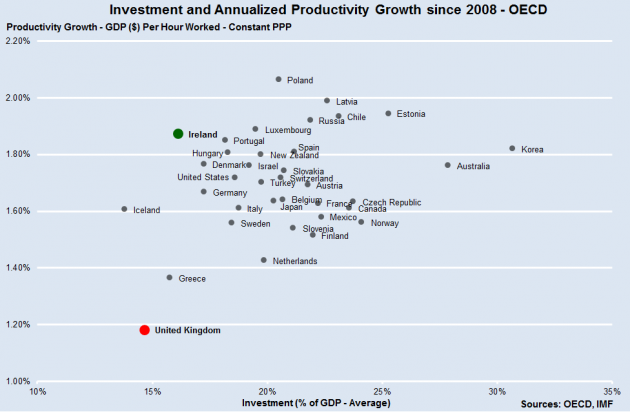Since the financial crash of 2008, and the Great Recession which followed, the UK has been struggling with a productivity crisis. Productivity, defined here as the increase in GDP per hour worked, increased very steadily in the UK for fifty years until 2008. Since then, productivity growth has halted entirely.
As is becoming traditional when looking at any sort of economic analysis, the situation in Northern Ireland is particularly bad. Northern Ireland has always had lower levels of productivity than England, Scotland, and the Republic of Ireland, but the stagnation in productivity growth over the last decade has seen the gap in productivity levels across the Irish border turn into a chasm. Whilst in 2004 productivity was 27% higher in the South, by the end of 2014 the value of the output of the typical worker in the Republic was 56% higher.
Whereas in 2004 productivity in Northern Ireland was in line with Spain, stagnation in productivity means that Northern Ireland has been overtaken by Slovenia, and other 2004 accession EU countries such as Poland and the Slovak Republic are not much further behind. Meanwhile, productivity in the Republic has overtaken Germany, and is now level with London.
Productivity is not just a dry, academic, concept. It matters, as it one of the key drivers behind wage growth and living standards. Countries and regions with falling or stagnating productivity levels are losing the global race to attract high quality, high paying jobs.
Admittedly, a key driver of the increase in Irish productivity was the fact that unemployment shot up during the Great Recession, meaning that output per worker increased due to a decrease in the number of workers. A similar effect was seen in the United States, and the subsequent recovery where output increased (but employment didn’t) was known as a jobless recovery. But the jobs came eventually, as the recovery continued, and the jobless recovery became a recovery of the ordinary sort.
There are a number of potential causes for Northern Ireland’s productivity problem. A key reason is the reliance on the public sector for employment. During the recession, few jobs were shed in the public sector, and as a result there were the same amount of workers producing less and less in terms of economic output.
The fact that public sector employers pay significantly more than private sector employers in Northern Ireland also distorts the labour market, as public sector workers will be disincentivized from moving to private sector jobs.
Northern Ireland has also been subject to many of the same factors affecting the rest of the UK. These include the fact that much private sector job creation has generally been of the low wage sort.
However, a key reason behind the productivity lag in the UK has been historically low levels of investment. Investment, in the economic sense, refers to the purchase of plant and machinery by firms, and the purchase of new houses and real estate by people.
The y-axis shows annualized growth in productivity since the financial crash, and the x-axis shows average investment as a portion of GDP. Whilst there is significant variation between countries and regions, there is a trend showing that countries with higher levels of investment are being rewarded with stronger productivity growth.
So, how can Northern Ireland encourage the investment that is so badly needed to boost productivity, wages, and living standards? In short, the Executive would need to be doing the precise opposite of what it has been doing.
The current brouhaha over welfare reform, and the ensuing nonsense regarding petitions of concern and ghost budgets, is creating an atmosphere of severe economic uncertainty. Businesses tend to crave stability and certainty when deciding whether to make investments or not.
The current impasse in Stormont has led to the situation where firms have no idea what the Corporation Tax rate will be in three years hence. I have previously been sceptical about whether a reduction in the CT rate is really the shot in the arm that Northern Ireland needs, but having made the decision to go for it, the current deadlock has complicated investment decisions for firms, and has made the Northern Ireland Executive look parochial and short-sighted to boot. Neither is a good look when trying to attract inward investment.
The continual strategy of threatening to bring down the Executive in order to extract further concessions from the Government in Westminster, is exacerbating the impression of Northern Ireland being an unstable place to invest in. It is also utterly self-defeating. If Northern Ireland is ever to get to grips with its productivity and living standards crisis, then brinksmanship must be replaced with grown-up politics which puts economic growth front and centre.
A qualified accountant and data analyst, interested in politics, economics and data. Twitter: @peterdonaghy
Discover more from Slugger O'Toole
Subscribe to get the latest posts to your email.

